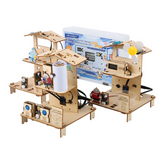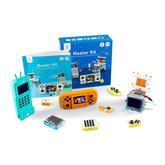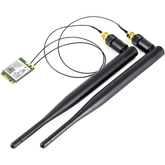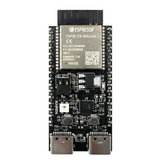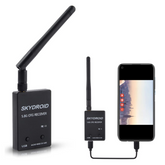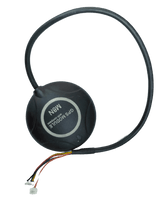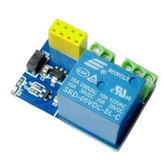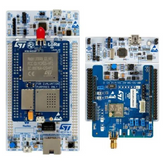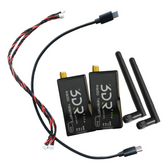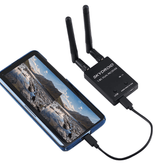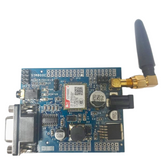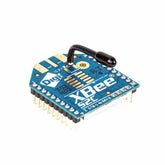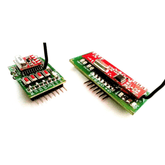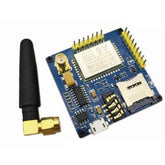-
HM-10 Bluetooth Module-China MakeHM-10 Bluetooth Module-China Make The HM-10 module is a small Bluetooth 4.0 module that utilizes the Texas Instruments CC2540 or CC2541 BLE System SoC (System on Chip). It operates on 3.3v SMD and can be controlled through the serial UART connection by sending AT...
- Rs. 234
Rs. 299- Rs. 234
- Unit price
- per
Save Rs. 65 -
AC8265 Wireless NIC for Jetson NanoAC8265 Wireless NIC for Jetson Nano This is an AC8265 Wireless NIC for Jetson Nano, WiFi / Bluetooth. The module is used to receive signals through NIC. NIC allows both wired and wireless communications. NIC allows communications between computers connected via a local area...
- Rs. 1,583
Rs. 1,809- Rs. 1,583
- Unit price
- per
Save Rs. 226 -
ESP32-WROVER Development Fixture BoardESP32-WROVER Development Fixture Board The ESP32-WROVER Development Fixture Board is the ultimate solution for developers working with ESP32-WROVER chips. This compact board is designed for easy and efficient programming, offering one-click firmware download and support for bulk programming without the need for individual chip...
- Rs. 618
Rs. 869- Rs. 618
- Unit price
- per
Save Rs. 251 -
ESP12F ESP8266 Amica NodeMCU Wifi Module CH340ESP12F ESP8266 Amica NodeMCU Wifi Module CH340 A great set of tools to develop ESP8266. NodeMCU is built based on the mature ESP8266 technology to take advantage of the abundant resources available on the web. NodeMCU has ESP-12-based serial WiFi integrated onboard to provide...
- Rs. 263
Rs. 349- Rs. 263
- Unit price
- per
Save Rs. 86 -
SMA Connector Female Straight Jack For PCB MountSMA Connector Female Straight Jack For PCB Mount The SMA Connector Female Straight Jack for PCB Mount is a precision RF connector designed for reliable performance in high-frequency PCB applications. With a 50-ohm impedance and through-hole mounting design, it ensures stable and low-loss signal...
- Rs. 19
Rs. 24- Rs. 19
- Unit price
- per
Save Rs. 5 -
NEO M8N GPS MODULE M5T GLONASS WITH ANTENNANEO M8N GPS MODULE M5T GLONASS WITH ANTENNA The Neo M8N GPS Module is the perfect solution for precision navigation in Robotics & DIY kits. It features concurrent GNSS technology, utilizing the high-performance M8 GNSS engine and an AssistNow service for faster acquisition. The...
- Rs. 2,271
Rs. 3,499- Rs. 2,271
- Unit price
- per
Save Rs. 1,228 -
4CH Remote Control Transmitter Receiver Circuit4CH Remote Control Transmitter Receiver Circuit Are you looking to buy a 4CH Remote Control Transmitter Receiver Circuit for your DIY projects? Look no further! This compact and efficient circuit measures 3.5 x 7 cm and is the perfect solution for all your remote...
- Rs. 148
Rs. 199- Rs. 148
- Unit price
- per
Save Rs. 51 -
Espressif ESP32-C6-DevKitC-1-N8 Development BoardEspressif ESP32-C6-DevKitC-1-N8 Development Board The Espressif ESP32-C6-DevKitC-1-N8 Development Board is a cutting-edge ESP32-C6 microcontroller board designed to power the next generation of IoT, smart devices, and wireless communication systems. Built around a 32-bit RISC-V single-core MCU, this ESP32-C6 development board offers a perfect balance...
- Rs. 1,089
Rs. 1,549- Rs. 1,089
- Unit price
- per
Save Rs. 460 -
SKYDROID UVC Mini FPV Receiver 5.8G 150CH for Android (Black)SKYDROID UVC Mini FPV Receiver 5.8G 150CH for Android (Black) Introducing the Skydroid UVC 5.8G Mini FPV Receiver, a small and powerful device that improves your FPV (First-Person View) experience. This receiver offers 150 channels, automatic frequency scanning, and a spectrum analyzer to help...
- Rs. 2,429
Rs. 4,199- Rs. 2,429
- Unit price
- per
Save Rs. 1,770 -
NEO M8N GPS Module with Compass for APM ARDUPILOTNEO M8N GPS Module By integrating a NEO M8N GPS module into your APM Flight controller, you can unlock the potential for autonomous flights. This cutting-edge NEO M8N GPS module, equipped with an onboard compass, is designed specifically for the APM Flight controller. It...
- Rs. 1,842
Rs. 3,299- Rs. 1,842
- Unit price
- per
Save Rs. 1,457 -
5V ESP8266 WiFi Relay Module5V ESP8266 WiFi Relay Module The ESP8266 WiFi 5V 1 Channel Relay Module equips with the ESP8266 WiFi module and micro-controllers, through the mobile phone APP to the module to send serial instructions to achieve in the LAN within the relay for wireless control. ...
- Rs. 195
Rs. 299- Rs. 195
- Unit price
- per
Save Rs. 104 -
STMicroelectronics P-NUCLEO-LRWAN2STMicroelectronics P-NUCLEO-LRWAN2 Meet the STM32 Nucleo starter pack for LoRa technology and advanced modulations! This uses the NUCLEO-F746ZG board with an STM32F7 microcontroller, paired with a RisingHF ARDUINO expansion board (LRWAN_GS_HF1). It acts as a strong LoRaWAN packet forwarder, smoothly connecting your data to...
- Rs. 14,563
Rs. 19,999- Rs. 14,563
- Unit price
- per
Save Rs. 5,436 -
3DR Radio Telemetry 433MHz 500mW(X6)3DR Radio Telemetry 433MHz 500mW(X6) This set of 3DR Radio Telemetry Module 433MHz 500mW allows you to establish a connection between a flight controller and a USB or UART-enabled device, such as a computer, laptop, or tablet with USB compatibility (OTG).The latest version 2...
- Rs. 6,124
Rs. 8,095- Rs. 6,124
- Unit price
- per
Save Rs. 1,971 -
3DR Radio Telemetry Kit 433MHz 500mW3DR Radio Telemetry Kit 433MHz 500mW The 3DR Radio Telemetry Kit has a 433Mhz frequency band and Receiver sensitivity to -124 dBm. This 3dr telemetry kit allows you to link to a flight controller to a USB or UART-equipped device such as a computer, laptop or tablet supporting...
- Rs. 2,043
Rs. 2,491- Rs. 2,043
- Unit price
- per
Save Rs. 448 -
SKYDROID FPV Receiver 5.8G OTG 150CH Video Downlink Receiver Double AntennaSKYDROID FPV Receiver 5.8G OTG 150CH Video Downlink Receiver Double Antenna The SKYDROID FPV Receiver 5.8G OTG 150CH Video Downlink Receiver Double Antenna for Android Phone PC Monitor is a powerful and versatile FPV receiver that can be used with a variety of devices....
- Rs. 3,324
Rs. 4,999- Rs. 3,324
- Unit price
- per
Save Rs. 1,675 -
SIM 800C GSM Modem with SMA AntennaSIM 800C GSM Modem with SMA Antenna This is SIM 800C GSM Modem with SMA Antenna, The baud rate range of the GSM Module can be easily configured using AT commands, allowing you to set it anywhere between 9600 and 115200. This versatile GSM...
- Rs. 643
Rs. 850- Rs. 643
- Unit price
- per
Save Rs. 207 -
Xbee S2C 2mW Wireless Module with AntennaXbee S2C 2mW Wireless Module with Antenna The XBee S2C is a wireless RF module that enables data exchange and communication using ZigBee mesh protocols, which are built on top of the IEEE 802.15.4 PHY. Designed for applications that require low latency and predictable...
- Rs. 2,655
Rs. 3,021- Rs. 2,655
- Unit price
- per
Save Rs. 366 -
433 MHz RF Transceiver Module433 MHz RF Transceiver Module This RF Transceiver Module provides a complete RF transmitter and receiver module solution which can be used to transmit data at up to 3KHz from any standard CMOS/TTL source. The transmitter module is very simple to operate and offers...
- Rs. 496
Rs. 662- Rs. 496
- Unit price
- per
Save Rs. 166 -
RF controlled BOTFeatures: Compact size and easy to assemble. LED indication on Remote Control module for easy output identification. Arduino based microcontroller board with in built motor driving circuitry. Onboard programming port which can be used for modification and upgradation. Line Follower Robot Quick start Guide:...
- Rs. 2,855
Rs. 3,226- Rs. 2,855
- Unit price
- per
Save Rs. 371 -
A6 GSM ModuleA6 GSM Module The GPRS Pro Serial A6 GPRS GSM Module Core DIY Development Board is a professional-grade development board that allows you to create your own IoT projects using the GPRS A6 module. The board supports dual-band GSM/GPRS networks and can be used...
- Rs. 564
Rs. 749- Rs. 564
- Unit price
- per
Save Rs. 185

Best Price Guarantee

Ready Stock for Bulk Purchase

Dedicated Account Managers
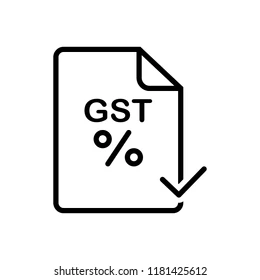
5% GST Benefits for Eligible SEZ and Edu

Technical Support Available

1-Year Manufacturer Warranty



